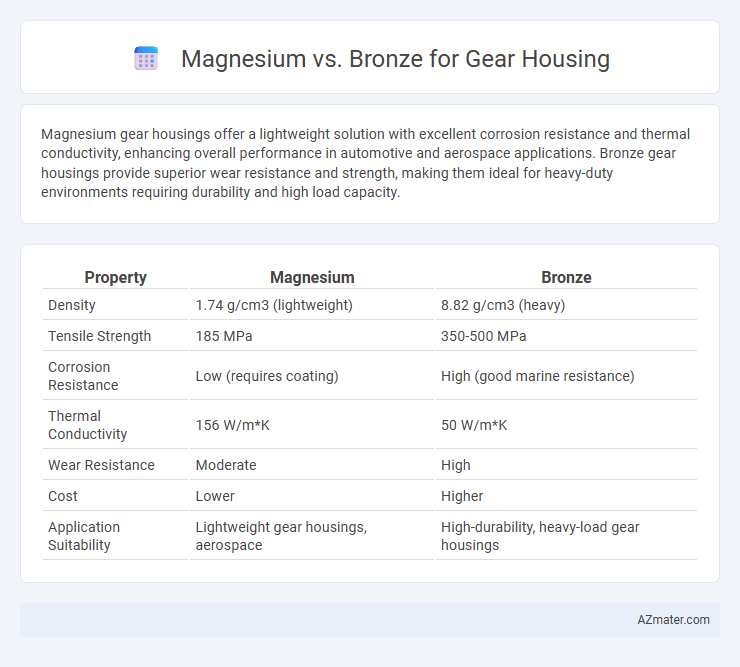Magnesium gear housings offer a lightweight solution with excellent corrosion resistance and thermal conductivity, enhancing overall performance in automotive and aerospace applications. Bronze gear housings provide superior wear resistance and strength, making them ideal for heavy-duty environments requiring durability and high load capacity.
Table of Comparison
| Property | Magnesium | Bronze |
|---|---|---|
| Density | 1.74 g/cm3 (lightweight) | 8.82 g/cm3 (heavy) |
| Tensile Strength | 185 MPa | 350-500 MPa |
| Corrosion Resistance | Low (requires coating) | High (good marine resistance) |
| Thermal Conductivity | 156 W/m*K | 50 W/m*K |
| Wear Resistance | Moderate | High |
| Cost | Lower | Higher |
| Application Suitability | Lightweight gear housings, aerospace | High-durability, heavy-load gear housings |
Introduction: Comparing Magnesium and Bronze for Gear Housing
Magnesium and bronze are two distinct materials commonly used for gear housing, each offering unique mechanical properties and durability. Magnesium is prized for its lightweight nature and excellent corrosion resistance, making it ideal for applications where weight reduction and thermal management are critical. Bronze, known for its superior wear resistance and strength, provides enhanced longevity and load-bearing capacity in heavy-duty gear housings.
Material Properties: Magnesium vs Bronze
Magnesium offers lightweight properties with a density of approximately 1.74 g/cm3, significantly lower than bronze's typical density of around 8.8 g/cm3, making it ideal for applications requiring weight reduction in gear housing. Bronze provides superior corrosion resistance and higher compressive strength, typically exceeding 400 MPa, compared to magnesium's tensile strength range of 150-250 MPa, enhancing durability under heavy loads. Thermal conductivity is higher in magnesium at about 160 W/m*K versus bronze's 60 W/m*K, allowing for better heat dissipation in gear housings.
Weight and Density Analysis
Magnesium gear housings offer a significantly lower weight due to their density of approximately 1.74 g/cm3, making them ideal for applications requiring lightweight components. Bronze, with a density around 8.8 g/cm3, is much heavier but provides superior wear resistance and corrosion properties. The weight advantage of magnesium results in improved fuel efficiency and easier handling, while bronze's higher density contributes to durability in heavy-duty environments.
Strength and Durability Considerations
Magnesium offers a high strength-to-weight ratio, making it ideal for lightweight gear housings where reducing overall weight is critical, but it generally has lower corrosion resistance and wear durability compared to bronze. Bronze exhibits superior strength and exceptional durability, with excellent resistance to wear, corrosion, and fatigue, making it a preferred choice for heavy-duty gear housings subjected to high stress and harsh environments. The choice between magnesium and bronze for gear housing depends on balancing weight reduction needs with the demands for long-term strength and material longevity.
Corrosion Resistance in Gear Applications
Magnesium gear housings exhibit lower corrosion resistance compared to bronze, making them more susceptible to environmental degradation in gear applications. Bronze offers superior corrosion resistance due to its copper alloy composition, which forms a protective oxide layer that prevents rust and wear. This makes bronze a preferred choice for gear housings in harsh or marine environments where longevity and durability are critical.
Thermal Conductivity and Heat Dissipation
Bronze offers superior thermal conductivity, typically around 50 W/m*K, enabling efficient heat dissipation in gear housings exposed to high-temperature environments. Magnesium, with a thermal conductivity of approximately 150-170 W/m*K, significantly outperforms bronze in conducting heat away from critical components, reducing the risk of overheating. This enhanced heat dissipation makes magnesium an optimal choice for lightweight gear housings requiring rapid thermal management.
Machinability and Manufacturing Ease
Magnesium offers superior machinability compared to bronze due to its lower hardness and density, enabling faster and more cost-effective manufacturing processes for gear housings. Bronze, while providing excellent wear resistance and strength, requires more advanced tooling and longer machining times, increasing production complexity. Choosing magnesium enhances manufacturing efficiency, especially in high-volume applications, but bronze remains preferred when durability and corrosion resistance are critical.
Cost Comparison and Availability
Magnesium gear housings typically offer a lower material cost due to the metal's abundance and lightweight properties, but machining expenses can increase overall production costs. Bronze, although generally more expensive as a raw material, provides greater wear resistance and corrosion protection, which may reduce long-term maintenance costs. Availability of magnesium alloys is widespread in automotive and aerospace industries, while bronze remains easily accessible through traditional metal suppliers, ensuring steady supply chains for both materials.
Application Suitability: Industrial Case Studies
Magnesium gear housings demonstrate superior lightweight properties and excellent thermal conductivity, making them ideal for aerospace and automotive applications where weight reduction enhances performance and fuel efficiency. Bronze gear housings exhibit exceptional wear resistance and corrosion protection, preferred in heavy industrial machinery and marine environments requiring high durability and longevity under harsh conditions. Case studies reveal magnesium alloys reduce overall system weight by up to 25%, while bronze housings increase operational lifespan by 30%, emphasizing application-specific material selection for optimal gear housing performance.
Conclusion: Selecting the Optimal Material for Gear Housings
Magnesium offers superior lightweight properties and excellent heat dissipation, making it ideal for applications where weight reduction and thermal management are crucial. Bronze provides exceptional wear resistance and mechanical strength, ensuring durability and longevity under high-stress conditions. Selecting the optimal material for gear housings depends on balancing these factors with specific operational requirements, prioritizing magnesium for lightweight efficiency and bronze for robust durability.

Infographic: Magnesium vs Bronze for Gear Housing
 azmater.com
azmater.com